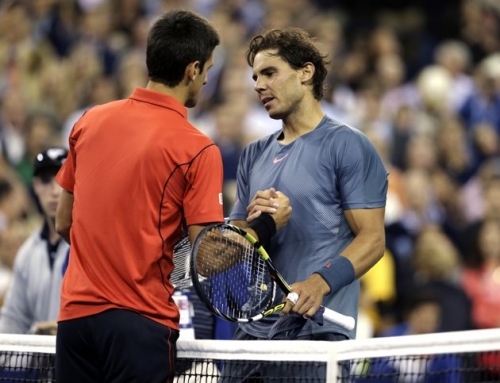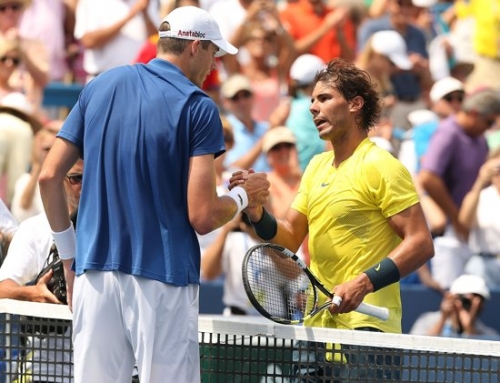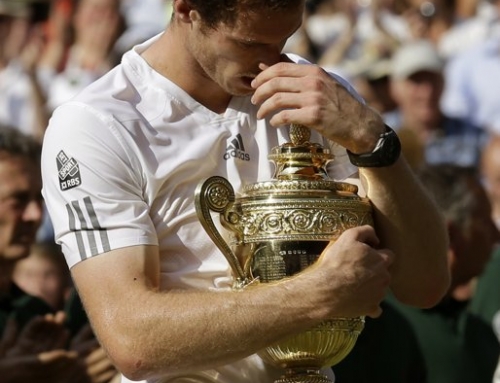 John Isner’s visibility to the sports world at large shot up on June 23, when an otherwise insignificant match was being played on an outer court, away from the hubbub of the show courts. 7 hours later, he and Nicolas Mahut had gone into history, playing the longest match ever, and even then, it wasn’t concluded. Another day and another hour and some change later, and Isner was on the court rolling, having finally broken serve.
John Isner’s visibility to the sports world at large shot up on June 23, when an otherwise insignificant match was being played on an outer court, away from the hubbub of the show courts. 7 hours later, he and Nicolas Mahut had gone into history, playing the longest match ever, and even then, it wasn’t concluded. Another day and another hour and some change later, and Isner was on the court rolling, having finally broken serve.
This victory came at a price. By the time he was done, he was fatigued, his neck hurt, his feet were raw, and he had nothing to give in his second round match, a straight set drubbing by the Dutch player, Thiemo de Bakker.
Isner’s fame grew, and he headed home. He was on the David Letterman show. He was on a morning show. He threw out a pitch at a Yankees game. He was soaking up the fame.
True tennis fans got an inkling of his talent when, given a wildcard to the Washington DC Legg Mason Classic in 2007, Isner went to the finals and gave Andy Roddick a tough match, one he ultimately lost, 6-4, 7-6. Isner would have a pretty quiet two years after that, before resurging again in the summer of 2009 when he would beat Andy Roddick at the 3rd round of the US Open before falling to Fernando Verdasco in the fourth round.
Isner would win his first title in Adelaide, and reach the finals of Memphis and Belgrade, losing both times to his doubles partner, Sam Querrey.
After Isner returned back to the US, he told reporters that he didn’t want to be known as “that guy”, the guy who played in the longest match ever. Although he had no pro aspirations early on in college, and had low aspirations once he graduated (hoping to be a top 100 player), he’s had to revise his goals in light of his current top 20 rankings. Now, he believes he can be a top 10 player, and perhaps even a Slam winner.
Is this possible?
One role model is Ivo Karlovic, who at 6’10”, is an inch taller than Isner. Karlovic lacked the kind of tennis instruction many of his contemporaries received from a very young age. So he worked on something he could do by himself: his serve. His serve became perhaps the most effective serve on the tour. Despite having a pretty big forehand, two things hampered Karlovic’s success. First, he lacked a world class backhand. To compensate, he learned to approach the net and volley. Second, he lacked much quickness. This meant if a returner could get a ball into play, and they had good groundstrokes, they could beat him by trying to move him around.
Isner has some advantages over Karlovic. Most notably, Isner moves better than Karlovic. His backhand is also better than Karlovic’s. However, neither is saying a great deal. Karlovic spent a long time trying to build his game to respectable pro levels, but he’s never gone particularly deep at a Slam. Karlovic played better at the age of 30 than he did at the age of 25.
Indeed, Isner, at the age of 25, is older than most pros that make it into the top 20. Players like Murray, Djokovic, and Nadal broke through when they were closer to 18. Isner wasn’t even ready to play pro tennis at 18, especially since he had to deal with a late growth spurt which took him time to adjust.
The better role model for John Isner is Juan Martin del Potro, although his game currently resembles Sam Querrey more than del Potro. del Potro is 6’6″ like Sam Querrey, but possesses the biggest forehand in tennis. When del Potro loads up, he gets players like Nadal and Federer struggling to reach the balls. Neither Isner nor Querrey hit a forehand as big, nor as consistently. The other player that is roughly like del Potro is Robin Soderling, who can also hit big on both sides, and do so consistently.
Isner has learned to hit a big forehand off shots up the middle. These are the same kinds of shots that Querrey is also good at hitting. Isner’s backhand, however, still needs more work, if he is to play closer to the del Potro style.
Pretty much every other player in the top 10, outside of del Potro, and to a lesser extent, Robin Soderling, and maybe even Andy Roddick, moves quick. Federer, Nadal, Murray, Djokovic, Davydenko, Tsonga, Verdasco–these guys are all pretty quick on the court. This is important because it helps them chase down balls that otherwise might be winners.
One reason the Isner-Mahut match lasted as long as it did was because Isner couldn’t play even when he got into rallies on Mahut’s serve. Mahut would dominate the rallies, and hit winners. This was more the case on the third day of their play. Indeed, one reason Isner got a chance to win was because Mahut altered his strategy, and came to net a lot more, giving Isner chances to pass. Mahut may have felt his abs were straining him and longer points from the baseline were not going to work long-term.
Isner may also have to worry about one more thing. At 250 lbs, he’s easily the heaviest guy on tour. Sure, his height contributes to that, and perhaps having more muscle might help avoid injuries, like basketball players. It may be that Ivo Karlovic, who is 20 lbs lighter, has a big frame that puts too much stress on his feet. Karlovic has had a foot injury that’s kept him off the tour for a few months now and doesn’t seem to be healing well.
Isner knows that there are some limitations to the style he can play. He’s not Andy Murray, so he can’t just rely on defense to win shots and chase down whatever an opponent gives him. Nor is he Davydenko, who takes balls off the rise, and hits them for winners off either wing. His best chance is to learn how to return serve much better, and that might be tough. He’s learned to keep rallies pretty short, and look for the short ball that he can punish. He needs a bit more agility too if he hopes to get in the top 10.
The good news, I suppose, is that taller players are making more of an impact. Players like Cilic, Querrey, del Potro, Tomas Berdych, and even Robin Soderling show tall players can play well, and perhaps move well enough to win. Right now, the quickest tall player is probably Andy Murray at 6’3″. Even though Soderling is only an inch taller, he doesn’t move nearly as well, but he compensates with a much harder hitting style. Plus Soderling is also pretty consistent hitting that hard, as is del Potro. Sometimes, looking at players like Querrey, you feel their strokes are good, but not intimidating, except for their quick strike shot.
Until Isner can show improvements in speed, or power and consistency, I think reaching the top 10 may take more work than he thinks. I think there will be a glass ceiling of sorts because of these limitations that will make him a solid top 20 player, but struggle to get into the top 10. But already, he’s shown to himself and others that he can exceed expectations, so it will be interesting to see if that happens.




![[US Open Men’s Final] Can Djokovic beat Nadal in the finals?](https://www.essentialtennis.com/wp-content/uploads/2013/09/20130909djokovic-500x383.jpg)


![[French Open] The tactics of the Djokovic-Nadal semifinals](https://www.essentialtennis.com/wp-content/uploads/2013/06/20130607nole-500x383.jpg)